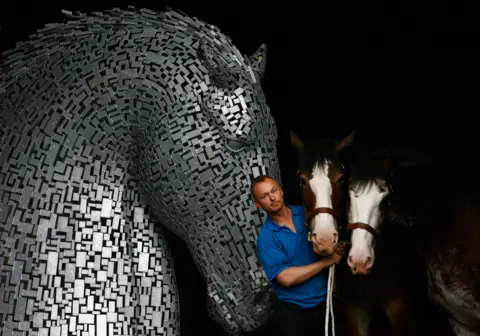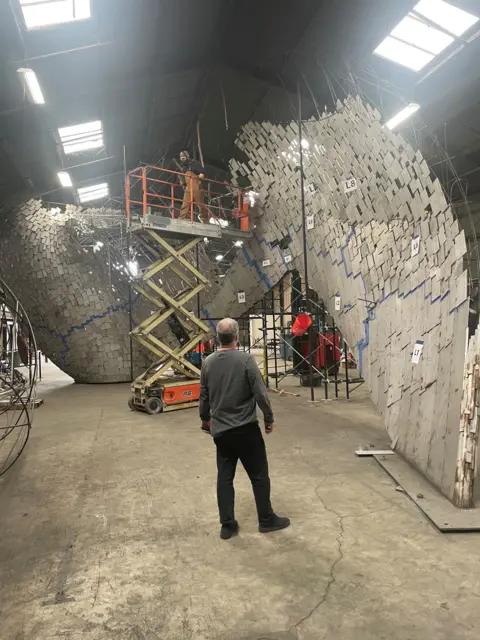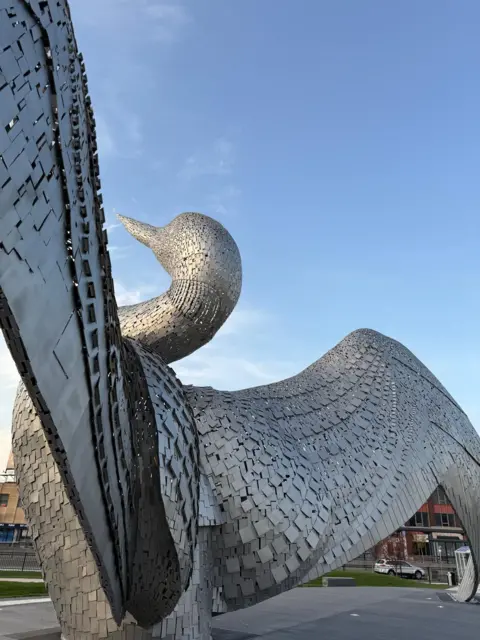ARTICLE AD BOX

 Henningson
Henningson
Andy Scott said the sculpture looks like it has always been there and always will be
The loon is the state bird of Minnesota, a black and white duck like creature with piercing red eyes.
It’s also the mascot of Minnesota United, whose owner Bill McGuire commissioned a giant steel sculpture of a loon, to sit outside the club’s new stadium in St Paul.
And if it looks familiar to Scottish audiences, that’s because it was designed by the same artist who created the Kelpies.


Andy Scott worked with university friend Chris Dyson on the Kelpies
Andy Scott and Chris Dyson first met in Maryhill in Glasgow, almost 20 years ago. Both had studied at Glasgow School of Art.
While Andy went on to set up his own sculptural studio, Chris studied thermal engineering and established a fabrication company.
With adjacent studios, Chris helped Andy with what was to become the biggest project of his careers, the Kelpies.
A hundred feet tall and 300 tonnes each, the two equine sculptures were modelled on the heavy horses which once towed barges along the canals.
Ten years on from the launch of the Kelpies in Falkirk, both Andy and Chris had relocated to the US, and once again found themselves sharing studio space, this time in Los Angeles.
And it was to Chris – and his wife Emily Womack, another Glasgow School of Art alumni – and their fabrication company Dyson and Womack that he turned when he was offered the Minneapolis commission.

 Getty Images
Getty Images
Sculptor Andy Scott modelled the Kelpies on Clydesdale horses
“You’re going to think this is a bit daft, but the only thing I knew about the loon back then was that it had been sampled on various dance tracks I used to listen to back in the Sub Club in Glasgow in the early 90s,” said Andy.
But after much research into the bird and its relevance to Minnesota, Andy came up with a design and asked Chris and Emily to build it, using the same shipbuilding techniques used on the Kelpies.
“There’s an element of trust about translating ideas to the scale you see now,” says Chris.
“We used modern process of scanning to envisage that scale. But there’s no technology which will allow you to create that scale. It has to be done by hand.”
“I sometimes feel like I’m the last dinosaur in town but I’m pleased to see there are clients still out there who appreciate that bespoke hand crafted element,” says Andy.
“When I walked into that great big workshop it was like seeing the millennium falcon taking shape. People were gobsmacked.”

 Andy Scott
Andy Scott
"The Calling" sculpture stands 11 metres (36 ft) high and has a wingspan of 30 metres (98 ft)
The next challenge was to put together all 65 steel pieces on site in Minneapolis.
At 11 metres (36 feet) high, with a wingspan of 30 metres (98 feet), The Calling is smaller than the Kelpies, but still made an impact on the community of St Paul.
“We spent 10 days on site,” said Chris.
“Some people came daily; they brought deckchairs and watched the sculpture take shape.
"First the wings and then the head of the loon and then it was pretty clear what it was.”
The Midway neighbourhood in which the Allianz Field sits has had a troubled few years.
It was at the heart of protests over the murder of George Floyd, an unarmed African American man during an arrest by Minneapolis police.
"It’s an area which falls between so many different sections of Minneapolis St Paul,” said Dan Wade who lives in the neighbourhood, and is both a fan of the football club and its growing collection of sculptural commissions.
“It’s also very transitional for good and for bad. In 2018/2019 the area was starting to develop; it was growing rapidly and then Covid hit.
"With the development of the stadium, a lot of people are holding onto their property, waiting for the value to go up and in doing so, are limiting the development of the area. But as the stadium develops, I think we’ll see that change.”
Others are less convinced.

 Laura Bird
Laura Bird
Mr Scott said the reception to the piece has been "overwhelmingly positive"
Fox Willis is an artist who has lived in the area for five years.
“From an art perspective the piece is honestly underwhelming,” she writes.
“I understand what it's meant to convey. The posture of the Loon is defensive and intimidating. It is meant to be a warning to challenging soccer teams.
"The way the piece is put together in metal is indicative of the strength of the team. The way the air flows through the pieces of metal that compose the figure is provocative in that it could be seen as the team being light on their feet and fast. I understand it. I get it. It's been done. *Yawn*"
“From a social perspective - as a poor community member who is lucky enough to have a stable living situation, who is passionate about housing and hunger justice - I am honestly appalled.
"No offense to the artist- but if this sculpture was really to better the community - the commissioner would have found a local Midway artist to design it. He would have put money back into the community that he is claiming to 'make better'."
For Andy Scott, who’s made around 90 pieces of public art, it’s an argument he’s heard before.
“With public art – you’re never going to please all the people all the time,” he said.
“But as an artist I try. I aim for a wide-ranging appeal. I leave it to others to do the abstract and esoteric stuff.”
“So far the response to The Calling has been overwhelmingly positive.
"Some are making good observations about the city and how it needs help in other directions but they’re putting it in the context that was intended that it’s about enhancing that environment and other social issues aren’t really the remit of the artist so let’s see it as a catalyst for onward improvement.”
“It does have some parallels with Falkirk in terms of that objective to regenerate and we’re proud to have been a part of that.
"It looks like it’s always been there, and always will be.”

 6 months ago
21
6 months ago
21








 English (US) ·
English (US) ·